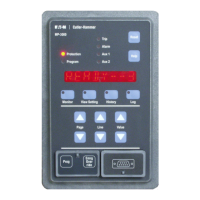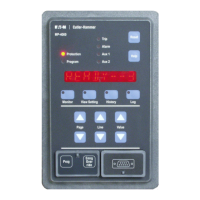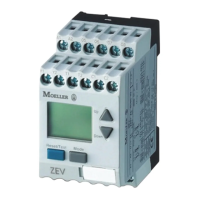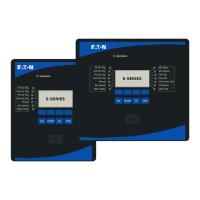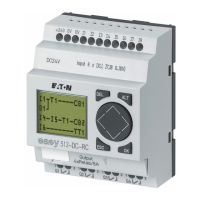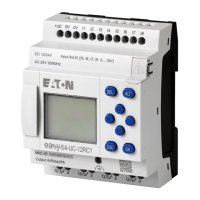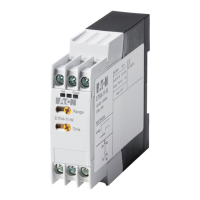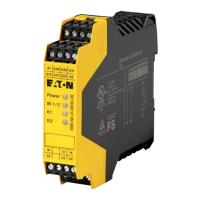For more information visit: www.cutler-hammer.eaton.com
Page 5-5
Effective 10/02 IL17562BH04
5.3.1 Setting P3L1, Ground Fault Trip Level (GFT)
Sets the ground fault trip current pickup in percent of ground Ct ratio
numerator (Ct rated primary current). For example, with a 50:5 ground
fault Ct and a setting of 24%, the GFT function will pick up at 24% of
50 A, or 12 A actual ground fault current in the motor. The start and/or
run delays must expire before the trip occurs.
NOTE
THIS IS THE ONLY PROTECTIVE CURRENT SETTING THAT DOES
NOT USE FLA AS THE BASIS FOR THE SETTING.
5.3.2 Setting P3L2, Ground Fault Start Delay (GFSD)
Sets the time from a motor start until the ground fault trip and alarm
functions are enabled, in power cycles. Use this to block GFT
operation until the ground current of power factor correction capaci-
tors decays after a start.
5.3.3 Setting P3L3, Ground Fault Run Delay (GFRD)
Sets the number of power cycles that a ground fault trip or alarm
operation must be maintained before the relay produces an output.
5.3.4 Setting P3L4, Instantaneous Over current Trip Level (IOC)
Sets the instantaneous over current trip limit in percent of FLA above
which the relay will trip. This trip type can be set to OFF. For currents
clearly above the setting, the IOC function picks up in two power
cycles or less. IOC operates only for high-current faults, and no run
delay is needed. Use with IOC Start Delay. Normally, set IOC above
1.5 times LRC. See Section 9.1.3.1.
The IOC setting must be below (1130 * PCT/ FLA) or 1600%,
whichever is less. PCT is Setting P1L5; FLA is Setting P1L1. If this
constraint is exceeded, you will not be able to exit program mode, but
will get a specific warning message instead.
5.3.5 Setting P3L5, Instantaneous Over current Start
Delay (IOCSD)
Sets the number of power cycles after a start is recognized until the
instantaneous over current trip and alarm functions are enabled. Use
this delay to inhibit IOC tripping on a current peak caused by
magnetic inrush when the motor is first energized—usually one to
three cycles.
5.3.6 Setting P3L6, Jam Trip Level (JMT)
Sets the motor jam current trip limit in percent of FLA. This element
can be set to OFF. Use with the jam start and run delays.
The jam trip function operates if the current rises well above FLA
during running, perhaps due to a mechanical jam in the load or a
sudden larger-than-intended load. For example, see the jam trip limits
set at 180% of FLA in the upper RUN portions of protection curves of
Figures 9.4 or 9.5.
The JMT setting must be below (1130 * PCT/ FLA) or 1200%,
whichever is less. PCT is Setting P1L5; FLA is Setting P1L1. If this
constraint is exceeded, you will not be able to exit program mode, but
will get a specific warning message instead.
5.3.7 Setting P3L7, Jam Start Delay (JMSD)
Sets the number of seconds after a start is recognized until the jam
trip and alarm functions are enabled.
Use JMSD to block jam trips during starting. Use even longer values
in high-inertia load situations where the acceleration time is longer
than the start time. In these cases, the motor current may remain
above FLA or JMT for some time after the transition from start to run.
5.3.8 Setting P3L8, Jam Trip Run Delay (JMTR)
Sets the number of seconds that a jam trip current level must be
maintained before the trip output occurs.
Use JMTR to block undesired jam trips for temporary large loads
which are normal for the process - for example, a heavy load suddenly
being placed on the conveyor belt which the motor must accelerate.
5.3.9 Setting P3L9, Underload Trip Level (ULT)
Sets the current level in percent of FLA below which the MP-3000
determines that the motor has lost its load and trips the motor. This
element can be set to OFF. Use with the underload start and run delays.
The Underload trip setting must be set at a value above the Stop
Current Threshold (STOP XX, P1L9) setting. Remember the Stop
Current Threshold is programmed as a percentage of PCT. To convert
this setting to be a percentage of FLA, multiply the Stop Current
Threshold by PCT/FLA. For example, if a 1000:5 Ct was used with a
motor that has a full load current of 500 amperes, and a Stop Current
Threshold of 5% was programmed, then the Underload Trip function
must be set above 10% of FLA.
5.3.10 Setting P3L10, Underload Start Delay (ULSD)
Sets the number of seconds after a start until the underload trip and
alarm functions are enabled.
5.3.11 Setting P3L11, Underload Trip Run Delay (ULTR)
Sets the number of seconds that current below the underload trip
setting must be maintained before a trip output.
5.3.12 Setting P3L12, Phase Unbalance Trip Level (UBT)
Sets the percent of phase unbalance above which the relay will trip.
This element can be set to OFF. The percent unbalance is calculated
from the ratio of negative sequence current to positive sequence
current. Use with the phase unbalance trip start and run delays.
For reversing starter applications (see P1L8), the MP-3000 assumes
that the larger sequence current is the positive sequence current, and
can trip for unbalance with the motor turning in either direction.
5.3.13 Setting P3L13, Phase Unbalance Start Delay (UBSD)
Sets the number of seconds after a start until the phase unbalance trip
and alarm elements are enabled.
5.3.14 Setting P3L14, Phase Unbalance Trip Run Delay (UBTR)
Sets the number of seconds that a high phase unbalance must be
sustained before a trip output.

